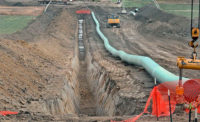 |
| WOODLEY |
At issue is the 1983 “Economic and Environmental Principles and Guidelines for Water and Related Land Resources Implementation Studies,” which applies to the Corps and three other agencies. It’s “the yardstick against which we measure projects,” says John Paul Woodley Jr., assistant Army secretary for civil works. “P&G” puts prime emphasis on projects’ contribution to “national economic development.” Environmental groups say it shortchanges ecological values.
| ||||||
The new “P&G” will apply only to the Corps, which plans a two-phase rewrite. It will first tackle broad standards, aiming to issue a draft in July for public comment, says Larry J. Prather, assistant director of civil works. Phase two will cover “procedures,” which he says are “detailed guidance for how to do benefit analysis.”
Prather says several items “almost have to show up in any revision.” They include having environmental quality and restoration as a stated project objective and a public-safety objective for flood-protection projects.
Prather says the Corps already has adopted environmental restoration as a “de facto” project objective. Environmentalists want to see that codified in “P&G.” April H.G. Smith, National Audubon Society director for ecosystem restoration, says ecological protection and restoration should have “equal footing with other Corps missions.”
he Army Corps of Engineers is moving quickly to rewrite the rulebook on how to plan, evaluate and carry out water projects around the country. In last year’s Water Resources Development Act, Congress mandated the first rewrite of the water- resources “Principles and Guidelines” in 25 years and told the Corps to finish it by November 2009. Judging from WRDA’s language and comments by officials from the Corps and interest groups at a June 5 public meeting, it’s clear the new “P&G” will give more weight to projects’ effects on the environment and public safety. Whether it will go far enough to satisfy environmental critics is an open question. Critics say the Corps is moving too fast. David Conrad, National Wildlife Federation senior water-resources specialist, calls the process “unacceptably truncated.” But Woodley says WRDA set a 24-month deadline, and 25% of that is gone. When a new administration takes office in January, he adds, it will have just 10 months to finish the task.


Post a comment to this article
Report Abusive Comment